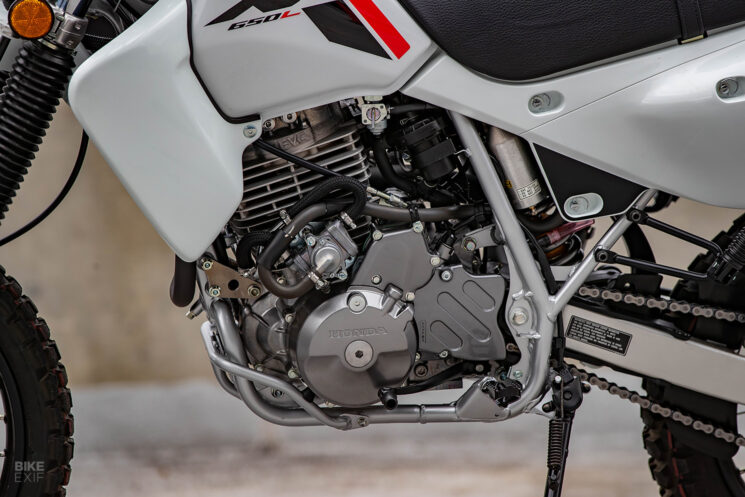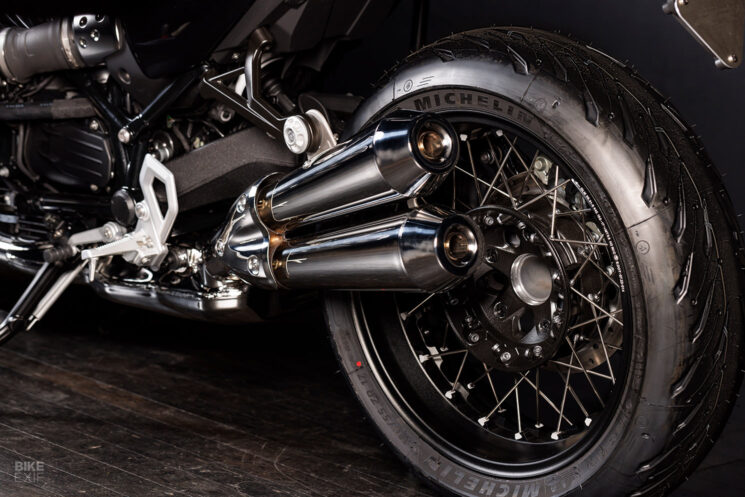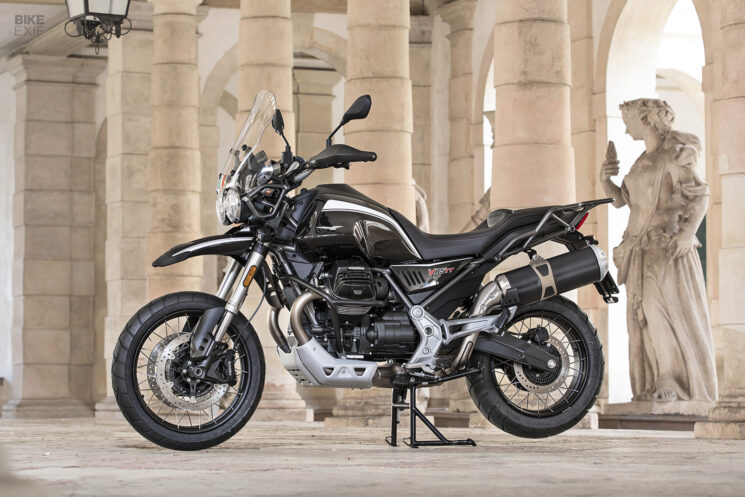
There’s no denying the performance advantage of liquid cooling, but if you’re of the opinion that air-cooled machines are obsolete, we say not so fast. The fact is that there are loads of air-cooled motorcycles you can still buy for 2024 in most every discipline of riding, offering significant upsides in MSRP, mechanical simplicity and fun factor. Instead of listing off every machine you could buy without a radiator, we’d rather point out the ones we’d put hard-earned dollars towards, and the results may surprise you.

Yamaha TW200 The enduring Yamaha TW200 is a bike that simply couldn’t exist with liquid cooling—it just wouldn’t make sense. With every facet of the bike designed for simple and reliable terrain domination, the TW will take you anywhere on the globe if you’re patient enough.

All arguments aside, the TW200 is the oldest bike you can still buy today with uninterrupted (and nearly unchanged) production since the 1987 model year. In 2001, Yamaha updated the Tdub with a front disc and ditched the kickstarter, but since then, changes have been limited to cosmetics. The carbureted 196 cc four-stroke delivers modest power through a five-speed transmission, and is capable of 70 mph if you’re light enough.
But it’s not highway blasting that the TW was designed for. Its ultra-low 31-inch seat height and chunky Bridgestone tires provide even novice riders with sure footing off-road, and low gearing allows the bike to climb just about anything the light-duty skid plate will clear. Its humble 28 mm Mikuni carburetor sips fuel, providing exceptional range from the 1.8-gallon steel fuel tank.

The Tdub community has a cult-like following, and you can customize a TW for serious off-roading, wild wow factor or stylish urban fun seeking. A new 2024 TW200 will set you back $4,999, up $100 from last year, but you can’t put a price on looking this good.

Honda XR650L Too often dismissed by your average dual-sport or light ADV rider, we’re convinced that anyone tough enough could get into the XR lifestyle if they test-rode one. It’s not light, and the seat sits high at 37 inches, but Honda’s XR650L has proven itself over the last 30 years to be an exceptional workhorse with bulletproof reliability.

Honda introduced the XR650L back in 1993 by combining the XR600R platform with a more powerful 644 cc engine from the NX650 Dominator. The air-cooled, SOHC engine produces around 40 hp, and has a gear-driven counterbalance shaft to smooth out the thumper’s operation. The transmission is a standard five-speed, but the XR’s 47 lb-ft of torque infrequently leaves riders wishing for another gear.
True to its roots, the XR is still based on a basic steel tube frame with an internal oil reservoir, and it’s shod in basic plastics and a steel fuel tank. There’s nothing flashy about the 43 mm Showa front forks and Pro-link rear shock, but you’ve got preload and compression adjustment, with a competitive 11” of travel on both ends.

Priced at $6,999, the XR650L is still one of the most capable new bikes you can buy for the money. It has everything you need to tackle extreme terrain, and enough grunt from the big air-cooled thumper to handle highway commuting. Whether you customize an XR with racks and screens for light ADV fun, strip it down to its simple utilitarian mechanicals for a throwback scrambler, or even just keep it stock, there’s no denying the XR650L is one of the best motorcycles ever built.
![]()
Ducati Scrambler Icon Ducati has done an admirable job of expanding its Scrambler brand, and while we’ll miss the outgoing Desert Sled dearly, there are still a few Scramblers in the stable we’d happily own. But even for 2024, there’s still something to be said about the versatility of the standard 803 cc Icon model. While it’s not as showy as some of the other variants, the Scrambler Icon still has all the right stuff for a thrilling ride, and it couldn’t be easier to customize.
![]()
The basic Scrambler looks a whole lot like it always has, but it’s fresh out of a major overhaul for 2023, with a revised chassis, swingarm and wheels in the name of making it lighter and more refined. Electronics took a massive leap forward as well, with Bosch cornering ABS, lean-sensitive traction control, a new 4.3-inch TFT dash and Road and Sport riding modes.
The heart of the Scrambler is Ducati’s desmodromic 803 cc L-twin, providing 73 hp and 48 lb-ft. And while it’s no powerhouse in the scrambler market, the air-cooled twin feels grunty and matches the Icon’s easy-going attitude. With the clutch reworked for an easier pull and fresh Euro 5 compliance, expect the 803 L-twin to remain the entry point into the Ducati scene.
![]()
Priced strategically at $10,995, the Ducati Scrambler Icon faces stiff competition from the likes of Moto Guzzi’s V7 and Triumph’s Scrambler 900. Between the three, the Ducati enjoys a handsome advantage in horsepower and a unique image. And if stock doesn’t do it for you, the Scrambler Icon has a huge selection of off-the-shelf parts to make it your own, and its simple air-cooled platform is a blank slate for modification.

BMW R 12 nineT Chiseled nostalgic lines, top-tier components and classic boxer cylinders hanging off the side are all noted hallmarks of the wildly successful BMW R nineT, but the company’s centennial has brought a new nineT to the party. Boasting refined cosmetics and a more powerful 1,200 cc air-cooled mill, the 2024 BMW R 12 nineT is poised to shake up the retro street scene.

BMW hasn’t revealed all on the new nineT, but from what we’re seeing, there’s a lot to like. Most of the changes over the outgoing nineT are visual, as BMW has reshaped a good deal of the bike’s profile. The new tank shape is a bit more retro, the air inlets above the cylinders are gone and the new side covers feel more vintage as well. The redesigned seat and tail section also boost throwback appeal, allegedly taking inspiration from the legendary R90S.
Information is pretty limited on the R 12 nineT’s powerplant, other than a displacement of 1,170 cc and the tried-and-true boxer air- and oil-cooling. If the mill was indeed lifted from the old R 1200 GS, power should come in north of 100 hp.

Other mechanical details of the R 12 nineT are much like you’d expect, with upside-down forks up front, BMW’s ‘Paralever’ swingarm at the rear, and 17” spoked wheels at both ends. Twin radially mounted four-piston monobloc Brembo calipers sit up front, hooked up to steel braided brake lines.
BMW has yet to announce other figures on the new R 12 nineT, including weight and MSRP, but for perspective, the old nineT sets you back $15,945.

Moto Guzzi V85 TT Next to the BMW boxer, there are few more iconic cylinder arrangements than Moto Guzzi’s air-cooled, transverse V-twins. Boasting top build quality and enough grunt to traverse all forms of terrain, the Moto Guzzi V85 TT proves there are still options for a top-tier air-cooled adventure bike.

Moto Guzzi’s V85 TT takes aim at the light ADV scene, with less bulk and more around-town practicality than most of the big 1,000-plus cc offerings. There’s no shortage of players in the market, including more powerful bikes like the BMW 850 GS and KTM’s 890 Adventure, but the V85 TT has a few tricks of its own. For one, its down-to-earth bodywork is refreshing in a segment dominated by sharp, angular lines, and the Guzzi’s air-cooled cylinders and dual headlamps have a timeless look. It’s also relatively cheap compared to many of its liquid-cooled peers at just $12,190 for the base V85 TT.

A 90-degree, 853 cc transverse mill powers the V85 TT to the tune of 79 hp, delivered to the rear wheel via shaft drive. Known for torquey performance, the Guzzi V-twin provides the majority of its torque before 4,000 rpm, and scoots along pleasantly on road or off. When the going does get rough, though, the 90-degree cylinders can affect comfort in the saddle.
Fit with an intuitive TFT display, excellent Brembo brakes and double-adjustable forks, the Moto Guzzi V85 TT is a serious player in the ADV scene. While underpowered slightly compared to offerings from BMW and KTM, the Guzzi will take you all the same places, and do it in unrivaled Italian style.
